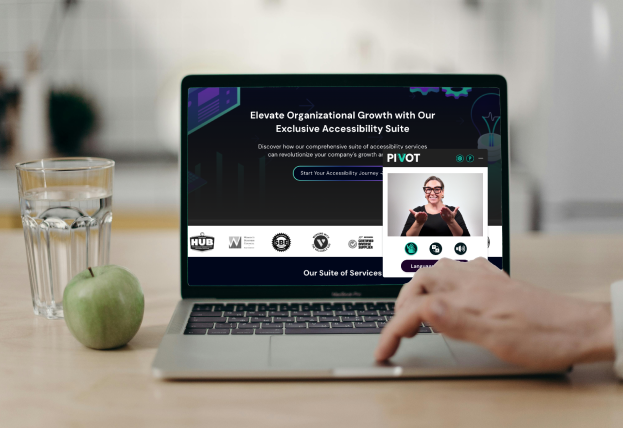In the fast-paced economy of digital content creation, even the most well-intentioned teams can stumble when it comes to accessibility. As a business leader, you’re tasked with ensuring your organization’s digital presence welcomes everyone—no small feat in an ever-evolving digital landscape.
Accessibility can feel overwhelming and confusing regardless of your industry. Standards keep changing, needs vary widely, and the fear of making mistakes can sometimes lead to paralysis. But here’s the thing—recognizing common mistakes is the first step toward creating truly inclusive digital experiences and reaching your target audience.
The Most Common Digital Accessibility Mistakes
1. Poor Color Contrast and Reliance on Color Alone
The Mistake:
Teams often choose colors based purely on brand guidelines or aesthetic preferences, without considering contrast ratios. Even worse, many use color as the only way to indicate important information, such as form errors or required fields.
The Impact:
- Users with visual impairments struggle to read text
- Colorblind users miss important information
- Content becomes unreadable in bright environments
- Brand appears exclusionary
The Fix:
- Use WCAG 2.1 recommended contrast ratios (4.5:1 for normal text, 3:1 for large text)
- Provide multiple visual cues beyond color (icons, patterns, text)
- Test your color combinations with contrast checker tools
- Create accessible color palettes that maintain brand identity
2. Missing or Inadequate Alt Text
The Mistake:
Either skipping alt text entirely, using generic descriptions (“image.jpg”), or providing overly verbose descriptions that don’t convey the image’s purpose.
The Impact:
- Screen reader users miss crucial information
- Search engines can’t properly index images
- Content meaning is lost for users with slow connections
The Fix:
- Write concise, purposeful alt text that conveys the image’s function
- For decorative images, use empty alt=”” attributes
- Include relevant keywords naturally
- Test your content with screen readers
3. Inaccessible Forms and Interactive Elements
The Mistake:
Creating forms and interactive elements that work only with mouse input, lack clear labels, or don’t provide adequate error feedback.
The Impact:
- Keyboard users can’t complete basic tasks
- Screen reader users don’t know what information to input
- Users with motor impairments get frustrated and leave
- Conversion rates suffer
The Fix:
- Ensure all functionality works with keyboard navigation
- Use proper label elements associated with form fields
- Provide clear error messages and success feedback
- Test forms with keyboard-only navigation
4. Non-Semantic HTML Structure
The Mistake:
Using div elements for everything, creating a flat document structure, or using headings for styling rather than organization.
The Impact:
- Screen reader users can’t navigate content effectively
- Search engines struggle to understand page structure
- Content becomes harder to maintain and update
- User experience suffers for everyone
The Fix:
- Use semantic HTML elements (nav, main, article, etc.)
- Create logical heading hierarchy (h1 through h6)
- Use ARIA labels only when semantic HTML isn’t possible
- Structure content for both visual and non-visual access
Breaking Through the Overwhelm
We often see teams freeze when faced with accessibility requirements. The fear of getting it wrong can sometimes prevent any action at all. Remember: accessibility is a journey, not a destination. It’s better to start making improvements incrementally than to wait for perfection.
Start with These Simple Steps:
- Audit Your Current State
- Run automated accessibility checks
- Review your most-used templates
- Test with actual assistive technologies
- Prioritize Fixes
- Address high-impact issues first
- Focus on frequently-used features
- Plan for sustainable improvements
- Build Team Knowledge
- Train content creators on accessibility basics
- Create accessible content templates
- Establish clear guidelines and checklists
The Cost of Inaction
While fixing accessibility issues might seem daunting, the cost of doing nothing is far greater:
- Lost market opportunity (61 million people in the U.S. have a disability)
- Legal risk and compliance issues
- Damaged brand reputation
- Decreased user engagement and conversions
How accesszanü Can Help
Creating accessible digital experiences doesn’t have to be overwhelming. Our team of accessibility experts can help you:
- Conduct thorough accessibility audits
- Develop practical remediation plans
- Train your team on best practices
- Implement sustainable accessibility processes
We understand the challenges you face because we’ve been there. Our approach combines technical expertise with practical experience, ensuring solutions that work in the real world.
Ready to Make Your Digital Content More Accessible?
Take the First Step:
- Book a free consultation to discuss your accessibility challenges
- Request an accessibility audit of your digital properties
- Schedule a team training session
Not Ready to Commit?
- Read our accessibility quick tips
- Subscribe to our newsletter for updates
- Explore our resource center for practical insights
It Just Feels Right
Creating accessible digital experiences isn’t just about compliance—it’s about building a digital world where everyone belongs. When you fix these common accessibility mistakes, you’re not just improving usability, you’re making a statement about your organization’s values and commitment to inclusion.
Ready to start your accessibility journey? Let’s talk about how we can help make your digital content accessible to everyone.
Contact accesszanü today at hello@accesszanu.com or call 323.287.5685 to discuss your accessibility needs.
Resources
- Web Content Accessibility Guidelines (WCAG) 2.1. W3C. https://www.w3.org/TR/WCAG21/
- W3C Web Accessibility Initiative (WAI). https://www.w3.org/WAI/
- WebAIM Contrast Checker. https://webaim.org/resources/contrastchecker/
- Understanding Success Criterion 1.4.3: Contrast (Minimum). https://www.w3.org/WAI/WCAG21/Understanding/contrast-minimum.html
- WebAIM: Alternative Text. https://webaim.org/techniques/alttext/
- The A11Y Project: How to Write Alt Text. https://www.a11yproject.com/posts/alt-text/
- WebAIM: Creating Accessible Forms. https://webaim.org/techniques/forms/
- W3C WAI-ARIA Authoring Practices. https://www.w3.org/WAI/ARIA/apg/
- MDN Web Docs: HTML: A good basis for accessibility. https://developer.mozilla.org/en-US/docs/Learn/Accessibility/HTML
- W3C: Using HTML Sections and Outlines. https://www.w3.org/WAI/tutorials/page-structure/
- CDC: Disability Impacts All of Us. https://www.cdc.gov/ncbddd/disabilityandhealth/infographic-disability-impacts-all.html
- WebAIM Million Report. https://webaim.org/projects/million/




